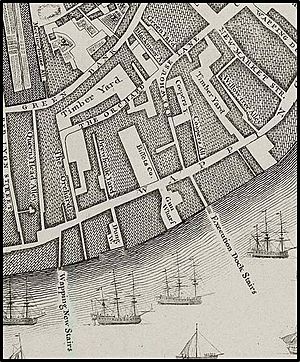Execution Dock facts for kids
Execution Dock was a place in the River Thames near the shoreline at Wapping, London, that was used for more than 400 years to execute pirates, smugglers and mutineers who had been sentenced to death by Admiralty courts. The "dock" consisted of a scaffold for hanging. Its last executions were in 1830.
History
The British Admiralty's legal jurisdiction was for all crimes committed at sea. The dock symbolised that jurisdiction by being located just beyond the low-tide mark in the river. Anybody who had committed crimes on the seas, either in home waters or abroad, would eventually be brought back to London and tried by the High Court of the Admiralty.
..... Those sentenced to death were usually brought to Execution Dock from Marshalsea Prison (although some were also transported from Newgate Prison). The condemned were paraded across London Bridge and past the Tower of London. The procession was led by the High Court Marshal (or his deputy) on horseback. He carried a silver oar that represented the authority of the Admiralty. Prisoners were transported in a cart to Wapping; with them was a chaplain who encouraged them to confess their sins. Just like the execution procession to Tyburn, condemned prisoners were allowed to drink a quart of ale at a public house on the way to the gallows. An execution at the dock usually meant that crowds lined the river's banks or chartered boats moored in the Thames to get a better view of the hanging. Executions were conducted by the hangmen who worked at either Tyburn or Newgate Prison.
With a particular cruelty reserved for those convicted of acts of piracy, hanging was done with a shortened rope. ..... It was called the Marshal's dance because their limbs would often be seen to 'dance' from slow asphyxiation. Unlike hangings on land, such as at Tyburn, the bodies of pirates at Execution Dock were not immediately cut down following death. Customarily, these corpses were left hanging until at least three tides had washed over their heads. This practice stopped at the end of the 18th century. .....
An account from The Gentleman's Magazine, dated 4 February 1796, gives a vivid portrayal of a typical execution at London's Execution Dock.
The infamous Captain Kidd, who had been convicted of piracy and murder, was taken from Newgate Prison and executed at the dock in 1701. During his execution, the rope broke and Kidd was hanged on the second attempt. His remains were gibbeted by the river Thames at Tilbury for three years.
George Davis and William Watts, convicted for piracy for the Cyprus mutiny, were the final hangings at the dock on 16 December 1830.
Location
Some sources state there is a large "E" on the Thames side of the building at Swan Wharf, indicating the site of Execution Dock. Another source states it was approximately where the London Overground station now stands.



